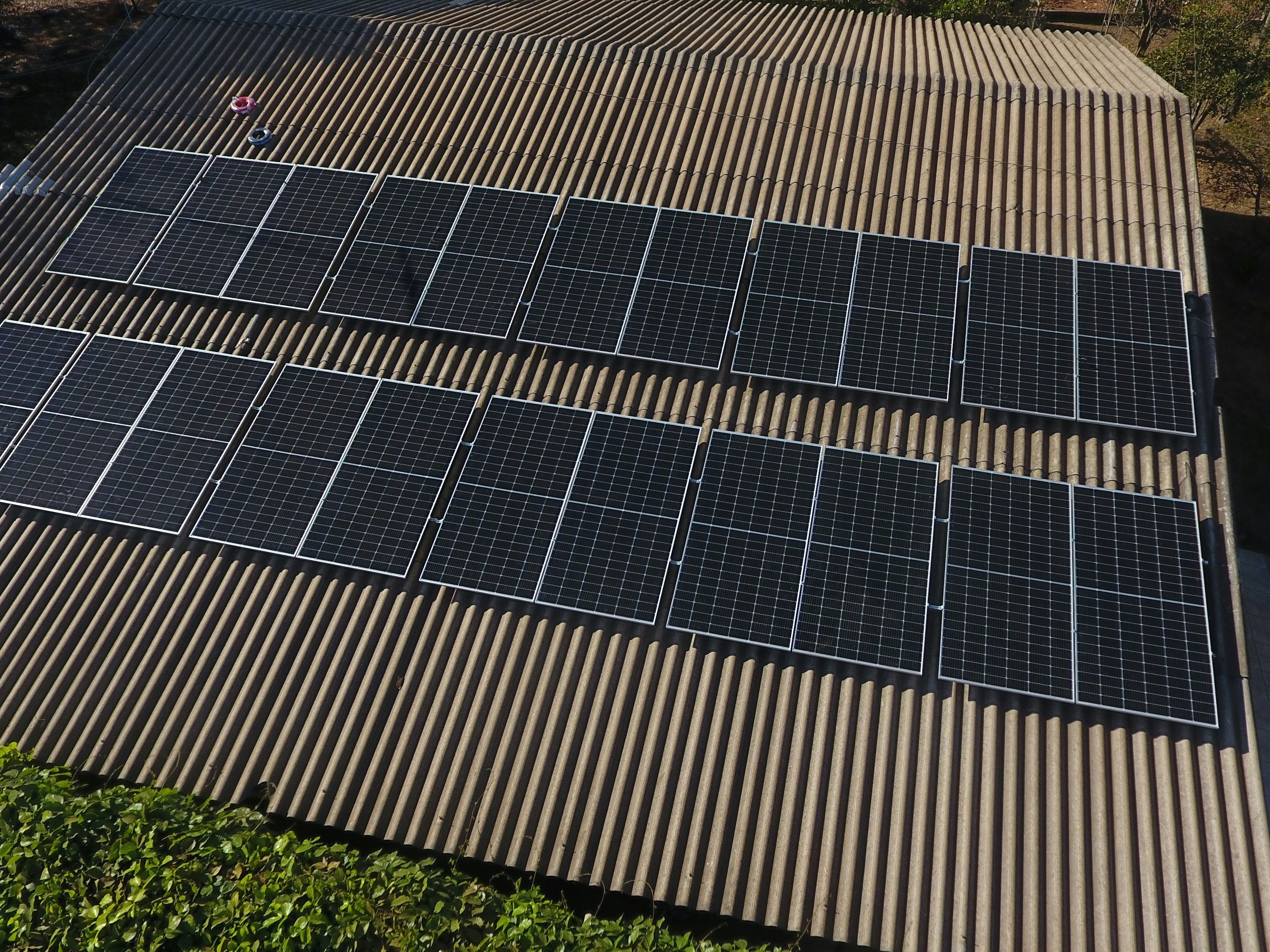Hybrid solar panels are now an intelligent choice for those who want to save electricity and care about the environment. This system spends solar energy and can still be connected to the PLN network, so you don’t worry about the lights to go out if the weather is not supportive. Many do not know that this technology can be installed at home with affordable capital. In addition to reducing monthly bills, hybrid solar panels also make houses more independent energy. This article will discuss how it works, its advantages, to tips on choosing a system that is suitable for household needs. Check out to know more detailed!
Also read: Solar Panel Future Renewable Energy Solution
What is a hybrid solar panel and how it works
Hybrid solar panels are smart systems that combine ordinary solar panel technology with storage batteries. The difference is the same as ordinary solar panels, this hybrid can save excess energy in the battery to use it when it is late or the weather is cloudy. This system also remains connected to the PLN network, so if the solar power is lacking, it can automatically withdraw the power of general electricity.
How it works is easy to explain: First, solar panels capture sunlight and turn them into DC electricity. Then, the inverter will conversion of DC electricity to the air conditioner to use at home. Excess energy that is not used is directly stored in the battery, not sent back to PLN like an ordinary on-grid system. If the battery is full and there is still residual energy, then sent to the PLN network.
The cool thing is, this system has intelligent control that can choose the most efficient energy source. For example, during the hot afternoon, the house will be full using solar power. When night or rain, automatically switch to the battery or PLN. The ability of this hybrid makes electricity bills down to 80% compared to using ordinary electricity completely.
For those who want to know more technical, you can read detailed explanations at the Ministry of Energy and Mineral Resources about the regulation of the installation of a hybrid system in Indonesia. Not just saving, this system is also more stable because it has energy backups from various sources. Very suitable for areas that often have rotating blackouts or for those who want to be independent of energy without the need to be separated from the complete public electricity network.
Also read: Electricity Saving Strategy and Energy Efficiency Policy
The advantages of the hybrid solar panel system compared to conventional
The hybrid solar panel system has many advantages that make the conventional system look out of date. The most obvious, hybrid can save energy in the battery, so it doesn’t really depend on the PLN network like an ordinary on-grid system or dead end at night like an off-grid system.
First about energy independence. The hybrid system can still turn on 24/7 because it has three resources: the sun, batteries, and PLN as backups. When an ordinary solar panel can only operate 8-10 hours a day, a hybrid system with a battery can supply electricity all day. The complete information can be seen at the ASEAN Center for Energy about the performance of the hybrid energy storage system in the tropical region.
Second, more long -term costs. Although the initial capital is more expensive because there is a battery, in 5-7 years it is usually already back in investment. This system can reduce electricity bills by up to 90% because it can maximize the use of solar power and minimize PLN rates. It’s different from conventional which sometimes gives excess electricity to PLN with cheap selling prices.
What is often forgotten, the hybrid system is more durable because the workload is more balanced. Inverters do not need to work hard continuously because there are batteries that arrange power flow. According to the International Renewable Energy Agency (Irena) research, the hybrid system has a 25-30 year lifetime-5 years longer than the ordinary system.
Plus, hybrid is scalable. Want to increase the capacity of just installing the battery or extra panel, no need to change the system from the start. Very suitable for those who think about future energy needs. About environmentally friendly? Certainly, by using more renewable energy and reducing dependence to fossil plants.
In short, hybrid is like having a personal power plant that is always standby, not just an ordinary electricity saver tool. Want PLN electricity to die, the house remains on. Want extreme weather, there is still a backup. No wonder now many houses, MSMEs, even industries that are starting to migrate to the hybrid system.
Also read: Biomass Power Plants Renewable Energy Solution
Important components in the hybrid solar panel system
If you want to install a hybrid solar panel, you need to know the main components that are connected to each other. This is different from ordinary solar panels that only need panels and inverters. The hybrid system is more complex but also more sophisticated.
First there Solar panel itself. This section still becomes the heart of the system that changes sunlight to DC electricity. For hybrids, usually use monocrystalline panels whose efficiency is higher (19-22%). According to Solar Energy Industries Association (SEIA), this type of panel is more optimal for energy storage systems because of its stable performance in low light conditions.
The second most vital component is Bank Battery. This is a place to save excess electricity to use later. Which is often used in the type of lithium-ion or lithium ferro phosphate (lifepo4) because of its long life (10-15 years) and safer. This battery capacity that determines how long the house can survive using electricity backup.
No less important hybrid inverter. This brain is a system that arranges electricity from the panel to the house, from the panel to the battery, or from PLN to the battery. Hybrid inverters are different from ordinary inverters because they can be multifunctional – can conversion DC/AC as well as regulating battery charging. More detailed technical information is on the energy storage association about the specifications of the hybrid inverter.
do not forget charge controller those who set battery charging so as not to overcharge. For sophisticated systems, usually already built-in in the inverter. Continue to exist Smart meter Create monitor production and consumption of real-time energy, plus transfer switch Automatically that can replace its own resources between Surya-Barag-PLN in a millisecond count.
Cables and grounding systems must also be considered because the voltage difference between panels (300-600V DC), batteries (48V DC) and houses (220V AC). Wrongly pairs can be dangerous. According to the International Electrotechnical Commission (IEC) standard, the installation of a hybrid system is required to meet special safety regulations.
Finally there is a monitoring system in the form of applications that can see the system performance of the cellphone. So it’s not just pairs and then forget, but you can know when to maintenance or upgrade certain components. Each of these parts supports each other so that the system can work optimally 24 hours in various conditions.
Also read: Edtech Business 2025 and Online Learning Trend
Guide to Choosing a Hybrid Solar Panel for Home
Choosing a hybrid solar panel for the house is not allowed to install. There are some crucial things that must be considered so that they are not wrong and effective in the long run.
First, first calculate daily electricity needs. Check the PLN bill in the last 3-6 months to know how much KWH is usually used per day. The ideal hybrid system can cover 70-80% of home energy needs. For example, your house consumes 20 kWh/day, means that a system that produces can be around 15 kWh. We can simulate the calculation using tools from the Ministry of Energy and Mineral Resources.
Second, adjust the battery capacity. This is very important to anticipate the use of night or cloudy days. The standard, choose a battery that can store at least 2x daily consumption. So if the house needs 15 kWh/day, it means the battery is at least 30 kWh. But this also depends on the budget because the price of lithium batteries is still expensive.
Third, choose the right hybrid inverter. Make sure:
- Able to handle the peak power of heavy equipment such as air conditioning or water heater
- Compatible with the type of battery selected
- Have a Smart Energy Management feature for power flow automation
- There is a minimum warranty of 10 years.
Which is often forgotten: adjust to the condition of the roof of the house. The area, the slope (20-30 ° ideal), and the direction of the face (East/West is still acceptable) determine the number of panels that can be installed. If the roof is narrow, you need high-efficiency panels to get maximum output.
For installers, you must choose a certified contractor such as registered in PLN or official association. They usually already understand the SLO (Operating Eligible Certificate) procedures and other licensing.
Last tips: ask for a modular scheme that can be developed. For example now install 2 kwp first, later if there is a budget can add panels or batteries without the need to change the system from the start. A good hybrid system is flexible and scalable to adjust future needs.
Also read: Energy Costs and Electricity Rates in Indonesia
Maintenance and Maintenance of Hybrid Solar Panels
Many think that the hybrid solar panel is a ‘installing then forgot’ system, but actually it takes periodic treatment so that the performance remains optimal. Proper maintenance can maintain system efficiency and extend the life of components.
For solar panels: Routine cleaning is mandatory, especially in the dusty dry season. Simply spray using ordinary water every 2-3 months-do not use chemicals or rough brushes that can damage the surface of the panel. Most importantly check there is no shadow from a tree or new building that blocks the sun. According to the National Renewable Energy Laboratory (NREL), 10% shading can just decrease energy production by 50%.
Battery System: This requires special attention. Check the storage temperature (15-25 ° C ideal) and make sure the ventilation is sufficient. If you use a lithium battery, usually already low-maintenance but it needs to be calibrated every 6 months so that the reading capacity is accurate. For lead-acid batteries, you should be more diligent in checking the water and terminal levels.
Hybrid Inverter: Clean the dust from the ventilation once a month, and make sure there is no loose cable. The alarm error at the monitor must be followed up immediately. Checking a wiring connection and firmware update also needs to be done annually by a professional technician.
Maintenance Software: Update monitoring applications regularly to get the latest features and security patch. A good hybrid system usually has a predictive maintenance feature that tells when to check certain components.
Record all examinations in the logbook – very useful for warranty claims or selling houses later. In general, fencing 1-2% of the price of the system per year for maintenance costs. The well -cared hybrid system can last 25+ years, much longer than being ignored.
Last Tips: Install the annual service contract with the installer. Usually they offer a complete maintenance standard including checking the grounding system and thermal scan so that they can detect problems as early as possible. Preventive maintenance is always cheaper than emergency improvement!
Also read: LED energy efficiency and home electricity savings
Cost estimates and return of investment hybrid system
Speaking of the cost of the Hybrid solar panel system, be prepared for a greater initial investment than a conventional system. But remember, this investment will return to investment by itself in a few years.
The average price of a household-scale hybrid system in Indonesia starts from Rp. 25-40 million for a capacity of 1 KWP including battery. The most expensive component is the lithium battery (50-60% of the total cost) with a price of around Rp. 15-20 million per 5 kWh. Professional installation costs are usually 10-15% of the total package price. If you want a more accurate number, try a simulation calculator from Indonesia Solar Energy Initiative.
But how come it’s really expensive? Actually, if calculated, the ROI is quite promising:
- 3 KWP system (Rp. 75-100 million) can reduce electricity bills of Rp1-1.5 million/month
- Assuming an increase in electricity tariffs 5% per year, usually return on capital in 5-7 years
- After ROI, electricity is free for 18+ years (system life)
Anyway now there is an incentive:
- 11% VAT discount for the Hybrid system (Minister of Finance Regulation No. 26/2023)
- Can sell excess electricity to PLN with net-metering (even though the price is lower than buying)
Interestingly, the value of home property usually rises 3-5% after the installation of the hybrid system. Data from the Green Building Council Indonesia shows that a house with diesel hybrid sells faster in the market.
The key is in the calculation of the right needs:
- Calculate daily electricity use (check kWh meter)
- Priority for important burdens (lighting, refrigerator, etc.)
- Choose a system capacity that cover 60-80% needs
For MSMEs or industry, ROI can be even faster because the electricity use is greater during the day. The hybrid system is long -term investment – the earlier pairs, the faster the cheap electricity is!
Also read: Sustainable Green Future Green Energy Solution
The trend of developing hybrid solar panels in Indonesia
The development of hybrid solar panels in Indonesia is very rising, driven by the surge in PLN electricity prices and higher renewable energy awareness. There are some interesting trends that will shaping the future of this technology in the next 5 years.
First, integration with smart grid. PLN starts trials of large -scale hybrid systems in several regions such as Nusa Tenggara and Maluku. The EBTKE Program at the Ministry of Energy and Mineral Resources is targeting 23% renewable energy in 2025, and Hybrid is one of the main solutions for off-group areas. In fact, there is a plans for a virtual power plant system where hundreds of houses with hybrids can be community power plants.
Local battery technology also began to appear. Companies such as PT LFX and Niko Battery have started lithium battery production for solar hybrid at a price of 30% cheaper than imports. The most innovative, there is an environmentally friendly saltwater battery research and suitable for tropical climate – still in the development stage in ITB and UI.
New business model Like Solar Leasing, it is popular. The Hybrid System Provider company offers a monthly payment scheme (starting at IDR 500 thousand/month) without initial capital. This system has run on several energy startups such as the main solar nuances and xurya. Very suitable for MSMEs who want to save electricity but don’t have big funds.
To be sure, regulations are increasingly supportive. Next year there will be a revision of ESDM Permen on Hybrid PLTS that will make it easy for licensing and exponal capacity with PLN. For household consumers, there is a hybrid battery subsidy discourse for the first 100,000 units that install.
My prediction, 2025-2030 will be the golden period of the hybrid system in Indonesia. Especially with the cheaper price of panels and batteries, plus AI technology for system optimization. What is clear, Indonesia has the potential to be the largest hybrid solar market in ASEAN if all of these factors can work together well.

Hybrid solar panel system is indeed an intelligent investment for the future of household energy in Indonesia. This technology combines the best of the two worlds-economical like ordinary PLTS plus Mandiri Energy like the off-grid system. In terms of cost, it really needs a bigger initial capital, but the ROI is 5-7 years fast with the right maintenance. The latest trends such as local batteries and solar leasing business models make this solution more affordable. To be sure, this hybrid system is not just a deduction from electricity bills, but a concrete step to make the house more sustainable and ready to face future energy tariff increases.


